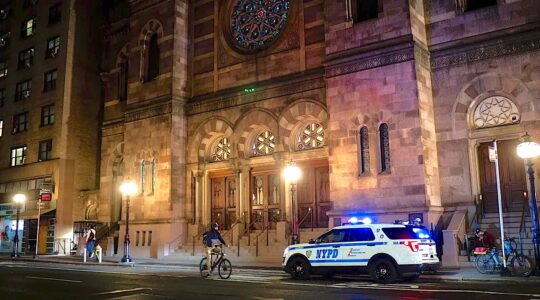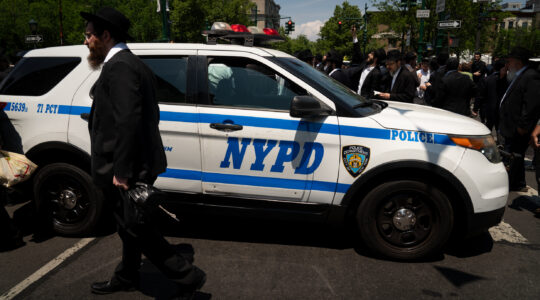Prague — As Sam Levine of Manhattan entered the Pinkas Synagogue in the Jewish Quarter here, his eyes darted about the room, scanning the names painted on the walls of Prague Jews killed in the Holocaust. Opposite the bima, his eyes rested on the names of Abraham Grunberg and his family. There was a lump in his throat. He reached out and kissed them with his hand.
“My mom told me to look for them,” he said, taking out a pen and paper to write down each member of the family.
How many were there? “I don’t know, I’m counting now,” the investment banker replied to the question. “Seven names. Helen, Edward, Emil. …”
“My mother’s mother’s name is Loris Grunfeld,” added Levine, 31. “I don’t know my relationship with these people; I just know we had family in Prague. According to this wall, they all died. It’s upsetting. I never knew them, obviously, but I still felt a bond. And in a different way, I have to bond with six million other [Holocaust victims].”
Levine was one of 200 members of national UJA’s Young Leadership division — 15 from UJA-Federation of New York — who experienced that bonding last weekend during a three-day mission to Prague. Among other sites, the group visited the Terezin, a “model” concentration camp, where Nazis allowed art to flourish. It was not, however, a place where life flourished. The Nazis shipped 140,000 Jews to the camp from Central Europe. From there, about 88,000 were deported to death camps (only 3,000 survived) and another 33,000 died in Terezin, from malnutrition and illness.
But the mission participants — who on Monday flew to Israel to join more than 3,000 other Jews for this week’s General Assembly of the UJA Federations of North America — did not come to Prague just to “memorialize the victims of the Holocaust,” pointed out Jerry Greenspan, 42, a real estate developer from Washington, D.C. “They came to celebrate the Jewish renaissance going on here.”
He said he learned about it in speaking with a group of young Jewish leaders in Prague and in being told that 45 children were enrolled in a Jewish day school and another 10 in a nursery school.
“Jewish life in Central Europe is nowhere near as dead as was predicted,” said Ed Serotta, a writer and photographer who specializes in Central Europe. “ In every Jewish community, no matter how small, there has been a rebuilding and a re-creating. Many of those communities probably do not have a rosy future. But dignity has nothing to do with quantity, and I have been chronicling for 10 years the dignity of their efforts.”
This mission was the largest gathering of a group of American Jews in Prague, according to Mark Talisman, who with Serotta was a scholar-in-residence for the trip. Talisman is president of Project Judaica Foundation, a 22-year-old organization dedicated to the preservation and exhibition of Prague Judaica. He said that although there is “no possibility of restoring the glories of the past here, the glories that exist today can be recognized in young [Prague Jews]. They were born Jews, but they want to know how to be Jewish instead of going into the woodwork the way their parents did [under Communist rule]. What we’re seeing [this weekend] is the globalization of the Jewish community. I’m sure there are going to be connections made between the young people of Prague and those [on the mission].”
Amy Bressman, 43, of Manhattan, said she felt that connection during Saturday morning services when mission leaders presented a Torah they brought from New York to a congregation here that did not have one. The congregation, called Beit Praha, is known as an “open” congregation that permits mixed seating and has devised its own Sabbath service. One of its founders, Lisa Frankenberg, said the city’s Orthodox congregation has three Torahs but that the country’s chief rabbi refused to permit Beit Praha to use one of them.
But the upbeat talk did not convince Arlene Simon, 39, a lawyer from Fort Lauderdale. Noting that the majority of Prague’s 1,200 Jews are more than 70 years old, she said she was not convinced that a rejuvenation of Jewish life here is possible.
“I simply don’t believe it,” she said over a dinner salad after returning from Terezin. “Europe’s a graveyard for the Jews. Those still here are old people. It’s a dying community. I know they are trying for a resurgence, but I don’t see this as a thriving community.”
But her sister, Joanne Goldberg, disagreed.
“I see it as a hopeful community,” said Goldberg, 32, a pediatric physical therapist from Montreal. “I think there is a resurgence. It can never be what it was, but it’s a positive thing that buildings are being returned to Jewish ownership and that there is a Hebrew school where Jewish values are being taught.”
Simon shook her head.
“For me, it’s too little, too late,” she said.
“It’s never too late,” interjected Chuck Konigsberg, 40, a White House legislative aide, who was sitting next to them. “You can always start something new. There’s so much history here, I never realized it.”
Lori Talish, 34, a television producer from Manhattan, said she saw the richness of the Jewish past when she visited three synagogues that have been converted into museums displaying the Judaica that Hitler collected from the Czech Republic’s 153 Jewish communities. It was his intention to make a museum exhibiting Judaica from the extinct Jewish people.
“I felt so much more connected seeing that,” she said.
Sam Levine found another way to stay connected. While standing near the crematorium at Terezin, he reached up to a tree that had been planted there in 1943 by a group of children and their teacher. He snapped off a sapling to plant when he returns to New York.
The New York Jewish Week brings you the stories behind the headlines, keeping you connected to Jewish life in New York. Help sustain the reporting you trust by donating today.




